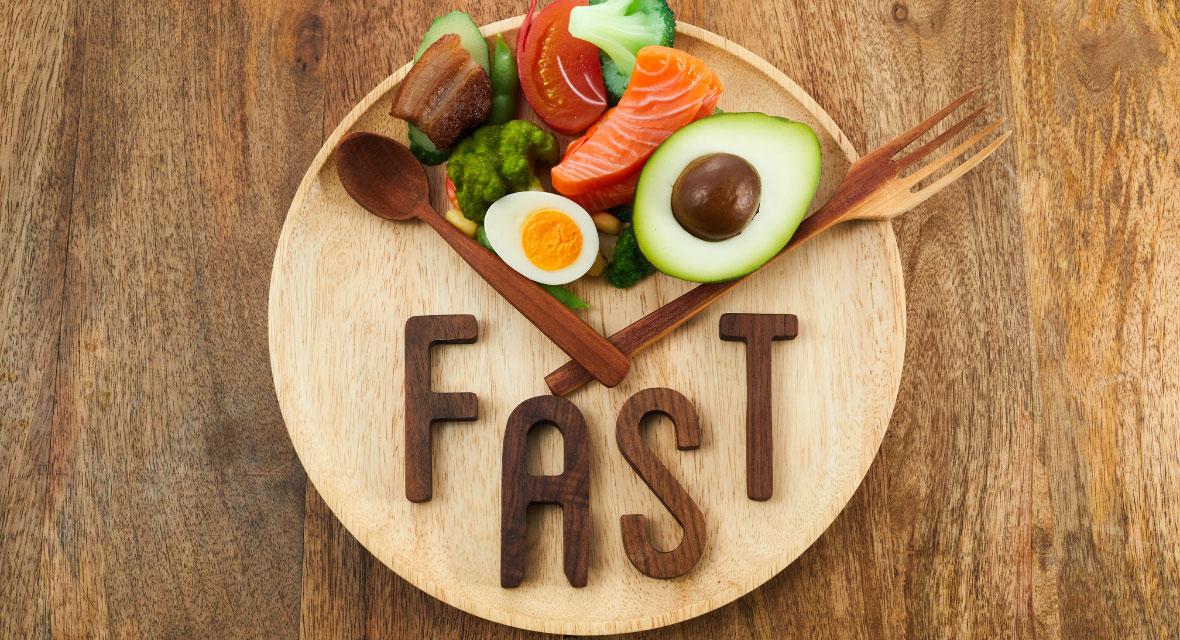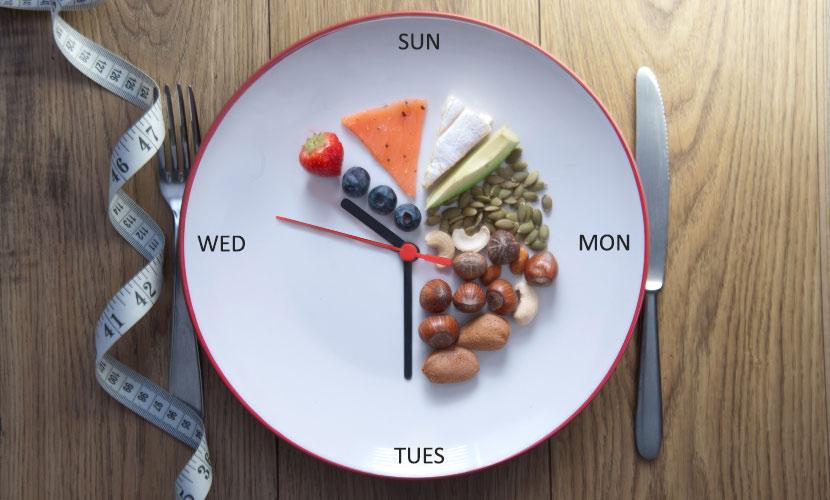🔥 Hot Days, Cool Meals – 15% Off on 4 & 8 Week Plans! 🔥
CODE: VM15

Intermittent Fasting Schedules: Which One is Right for You?
The concept of intermittent fasting (IF) has garnered significant attention due to its potential positive impact on various aspects of well-being. This approach is grounded in the idea that controlled periods of food consumption and abstinence can trigger a range of physiological responses contributing to improved health outcomes. By delving into the diverse IF schedules, individuals can tailor their fasting regimens to align with their unique goals and lifestyles.
Understanding Intermittent Fasting
Intermittent fasting, a form of healthy fasting, revolves around alternating cycles of eating and fasting periods. This strategy focuses less on what you eat and more on when you eat it. The primary goal is to manipulate the body's metabolic processes to achieve various health benefits. During non-eating intervals, the body exhausts its glycogen stores and begins tapping into fat reserves for energy, which may cause weight loss and better insulin sensitivity.
Various IF methods tap into the body's adaptive responses, potentially aiding weight management, improving metabolic health, and promoting cellular repair processes. This approach may enhance insulin sensitivity, reduce inflammation, and support cognitive function. However, individual results may vary. Consulting a healthcare professional before embarking on any fasting regimen is advised.
6 Different Types of Intermittent Fasting Methods
14/10 & 16/8 Method: Leverage Daily Fasting
The 14/10 method involves a 14-hour fasting window followed by a 10-hour eating window within a 24-hour cycle. This intermittent fasting approach has gained popularity for its potential health benefits and its compatibility with healthy meal plans. During the non-eating period, non-caloric beverages like water, herbal tea, or black coffee are consumed.
The 16/8 method features a 16-hour fasting window followed by an 8-hour eating window. Both approaches aim to leverage the body's natural fasting and feeding rhythms. While the 14/10 method offers a slightly shorter non-eating duration, the 16/8 method is more common and allows individuals to skip breakfast, making it adaptable to different lifestyles.
Adapting the eating window in these schedules requires mindful adjustments and addressing challenges.
- Gradually shift your eating window by 15-30 minutes daily to ease into the new schedule.
- Prioritize nutrient-dense foods to make the most of your eating period.
- Stay hydrated during the food restriction hours.
- Manage hunger by consuming fiber-rich foods and healthy fats.
5:2 Method: Caloric Restriction on Non-Fasting Days
The 5:2 method is an approach where individuals eat normally for five days of the week and restrict their calorie intake to around 500-600 calories on the remaining two non-consecutive days. This pattern allows the body to experience IF while still enjoying regular meals most days. The non-eating days should be spread throughout the week to avoid consecutive food restriction periods. Adherence to nutritious foods is crucial to maximize the benefits.
The caloric restriction followed in this method offers several benefits. It can promote weight loss and support fat loss, leading to improved metabolic health and reduced risk factors for chronic diseases like diabetes and cardiovascular conditions.
However, drawbacks include potential nutrient deficiencies if not carefully planned, which can impact overall health. The extreme caloric restriction might lead to muscle loss and lowered energy levels. Psychological effects like irritability and food obsession could arise. Balancing nutrient intake and focusing on sustainable, nutrient-dense foods can mitigate these concerns.
Crafting balanced meals is vital for optimal intermittent fasting results. Some tips include:
- During food restriction phases, hydrate with water, herbal tea, or black coffee.
- For eating phases, prioritize nutrient-dense foods.
- Break the fast with a balanced meal including protein, healthy fats, and complex carbs to sustain energy.
Eat-Stop-Eat: Intermittent 24-Hour Fasting
The Eat-Stop-Eat method is an approach characterized by 24-hour fasting periods practiced once or twice a week. During these non-eating intervals, individuals abstain from consuming any calories, relying solely on non-caloric beverages. After the food restriction period concludes, regular eating habits resume. This approach aims to create a calorie deficit, promoting weight loss and improved metabolic health. The extended food restriction duration challenges the body's metabolism, potentially enhancing fat-burning and cellular repair processes.
During longer fasting periods of this method, significant physiological changes occur. As the body depletes its glycogen stores, it transitions into a state of ketosis, where it relies on stored fats for energy. Insulin levels drop, promoting fat breakdown. Cellular repair mechanisms, like autophagy, intensify, removing damaged components. While these changes support fat loss, they can also improve insulin sensitivity and reduce inflammation.
While practicing IF, it is essential to maintain proper nutrition and hydration to support overall health, especially when incorporating monthly meal plans. Prioritize nutrient-dense foods rich in vitamins, minerals, and essential nutrients during eating windows to prevent deficiencies. Include lean proteins, whole grains, healthy fats, and plenty of vegetables. Consider individual dietary needs, health conditions, and physical activity levels when planning meals.
Alternate-Day Fasting: A More Intensive Approach

Alternate-day fasting is a distinct method gaining attention for its potential health benefits. This involves alternating between fasting days, where caloric intake is greatly reduced or eliminated, and regular eating days. As a more intensive regimen, this approach requires careful consideration and monitoring of nutrient intake during eating windows.
Modified and strict alternate-day fasting differ in their approach. Modified fasting allows for limited calorie intake (around 500 calories) on non-eating days, making it potentially more sustainable for some individuals. Strict alternate-day fasting, on the other hand, involves a complete caloric restriction on food restriction days, potentially leading to quicker weight loss and more intense physiological effects. However, it can be challenging to sustain due to its intensity. Choosing between them depends on individual preferences, goals, and ability to adhere to stricter regimens.
Alternate-day fasting can lead to substantial weight loss due to the calorie deficits created while you are not consuming any food. Improved insulin sensitivity, observed with reduced insulin levels, may lower the risk of type 2 diabetes. This approach might also enhance heart health markers, reduce inflammation, and support cellular repair processes through autophagy.
The Warrior Diet: Fasting and Feasting Daily
The Warrior Diet is an intermittent fasting approach that alternates between periods of undereating and overeating within a 24-hour cycle. During the 20-hour food restriction phase, minimal calories are consumed through raw fruits, vegetables, and small amounts of protein. The remaining 4-hour eating window permits larger meals comprising whole, unprocessed foods. While it can aid weight loss, enhance metabolic health, and encourage mindful eating, individual suitability, and adherence must be considered.
This method is rooted in the idea of emulating the eating habits of ancient warriors, who often consumed minimal during the day and indulged in larger meals at night. This approach aligns with the natural circadian rhythm and the body's adaptive mechanisms. Historical references to warriors and hunters adopting similar patterns for sustained energy have influenced the development of this method.
Adapting the Warrior Diet to modern lifestyles involves tailoring its principles to accommodate daily demands. Flexibility is key, allowing the food restriction window to align with work and social schedules. Emphasis should remain on consuming nutrient-dense foods during the 4-hour eating window. Incorporating whole grains, lean proteins, and diverse vegetables supports sustained energy. Personal preferences, health considerations, and consultation with professionals aid in successfully integrating this approach into modern life.
Intermittent Fasting Benefits
Some of the potential benefits of intermittent fasting are:
- Creates a calorie deficit, aiding in shedding excess weight.
- Enhances the body's response to insulin, reducing the risk of type 2 diabetes.
- Triggers autophagy, a process that removes damaged cells and promotes cell health.
- May lower inflammation markers, contributing to better overall health.
- Simplifies meal planning and timing, making eating patterns more manageable.
- Encourages mindfulness and awareness of food choices.
The Role of Exercise during this Healthy Fasting Approach

Engaging in physical activity during the eating window can promote muscle retention while encouraging fat loss. Exercise supports metabolic flexibility, helping the body switch between fuel sources efficiently. It aids insulin sensitivity, further enhancing the effects of fasting on blood sugar regulation. However, intense workouts might be better suited during eating periods for adequate energy. Listening to your body and adjusting exercise intensity is essential, especially during non-eating phases.
Common Mistakes to Avoid and Precautions
When practicing IF, it's important to be mindful of common mistakes and take necessary precautions to ensure your well-being.
Mistakes to Avoid
- Fasting doesn't mean neglecting water intake; stay hydrated.
- Don't compensate by consuming excessive calories during eating windows.
- Avoid overly aggressive schedules; gradual adjustment is better.
- Listen to your body; if genuinely hungry, eat within the eating window.
Precautions
- Some medications may require adjustments in timing or dosage; discuss with your doctor.
- Drink enough water to prevent dehydration.
- Ensure you're getting a balanced diet and adequate nutrients during eating windows.
- Maintain consistency with your schedule to allow your body to adapt.
Which One is the Best Option for Me?
The best IF method depends on various factors, including your lifestyle, health goals, preferences, and any underlying health conditions. Some methods are great for those who prefer a daily routine, while some are suitable for individuals looking for a flexible approach. It's crucial to consider your health status and consult a healthcare professional or registered dietitian before starting any regimen. They can help determine the best approach based on your individual needs and circumstances.
Conclusion
Intermittent fasting presents a versatile and potentially beneficial approach to managing weight, improving metabolic health, and promoting overall well-being. With various methods to choose from, you can tailor your regimen to align with your preferences and goals. By combining informed decisions with proper hydration, balanced meals, and regular exercise, you can harness the potential benefits while prioritizing your health and holistic wellness.
Reach out to start your fitness journey with us!
Meal Plans
Delivery Details
Legal Information
© 2020-2024 VMeals. All rights reserved. VMeals™ is a trademark of Flip Side Restaurant and Cafe L.L.C
We accept
